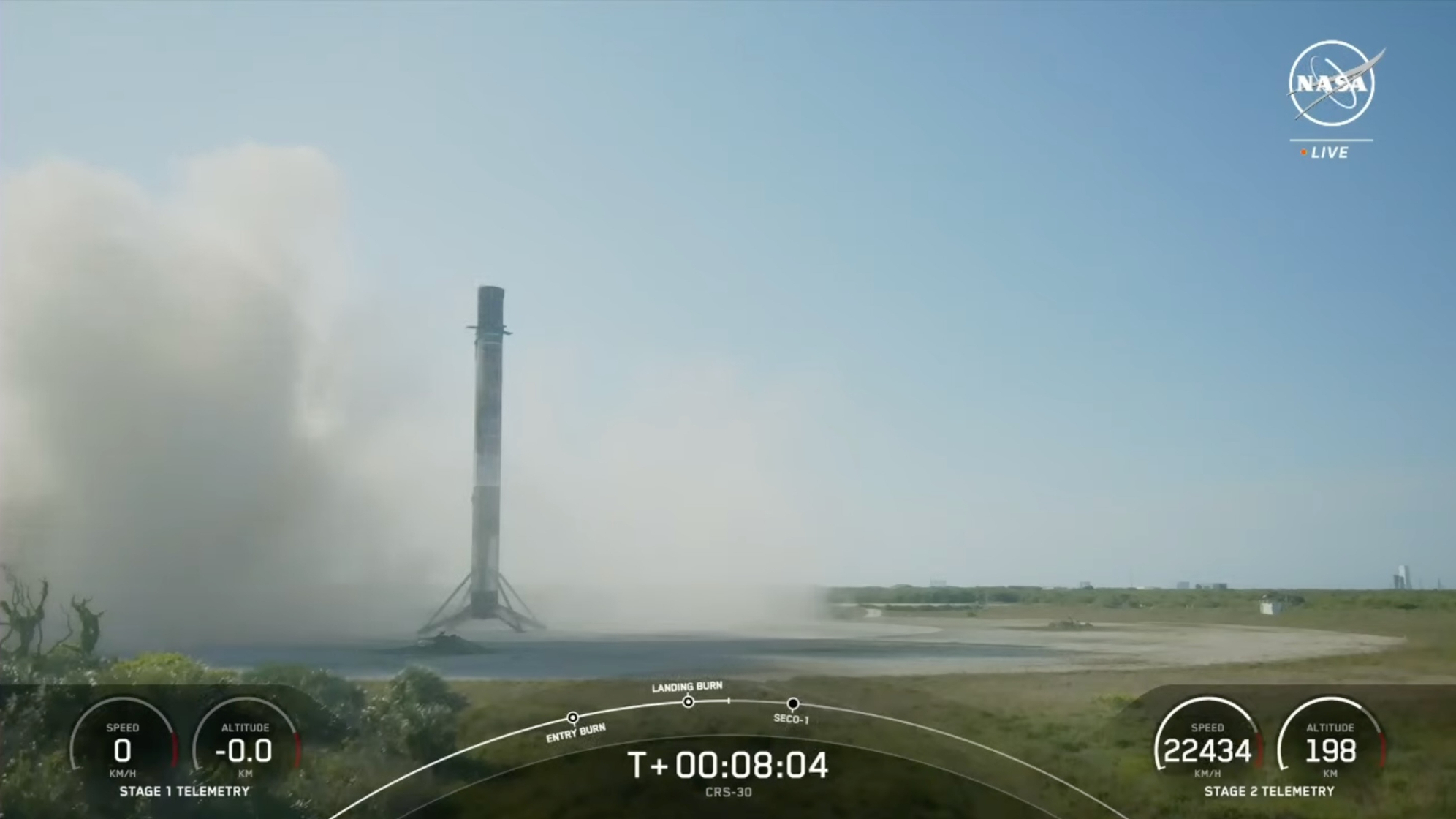SpaceX launches its 30th Dragon cargo mission to the ISS (video)
Dragon is scheduled to arrive at the space station on Saturday morning (March 23).
SpaceX launched its 30th cargo mission to the International Space Station (ISS) for NASA this afternoon (March 21), carrying 3 tons of supplies and scientific hardware to the orbiting lab.
A Falcon 9 rocket carrying an uncrewed Cargo Dragon spacecraft lifted off today at 4:55 p.m. EDT (2055 GMT) from Space Launch Complex-40 (SLC-40) at Cape Canaveral Space Force Station in Florida.
The mission, known as CRS-30, was the first cargo launch from SLC-40 since March 2020. Since then, the pad has been outfitted with a new launch tower, which allows for more efficient cargo loading and upgrades the facility to support crewed launches as well.
Related: SpaceX to launch 30th cargo mission to the ISS for NASA this week
Before the SLC-40 upgrades, "we loaded cargo while the vehicle was still horizontal using a mobile cleanroom before we would take the vehicle vertical for lunch, but thanks to this new state of the art crew tower, required for our human spaceflight missions, that late-load cargo operation got a massive upgrade, too," Sarah Walker, director of SpaceX Dragon mission management, said during a pre-launch press briefing on Tuesday (March 19).
"It's much easier to load a huge complement of time-critical NASA science into our Dragon spacecraft in the flight orientation," she added.
The Falcon 9's first stage booster came back to Earth as planned today, making a vertical touchdown at SpaceX's Landing Zone-1, at Cape Canaveral Space Force Station, about eight minutes after launch. It was the sixth launch and landing for the booster, according to a SpaceX mission description.
Breaking space news, the latest updates on rocket launches, skywatching events and more!
The CRS-30's Cargo Dragon capsule separated from the rocket's upper stage just under 12 minutes after launch. The spacecraft will spend around two days en route to the ISS, with a rendezvous and docking scheduled for 7:30 a.m. EDT on Saturday (March 23). You can watch that orbital meetup live here at Space.com, courtesy of NASA, beginning at 5:30 a.m. EDT (0930 GMT) on Saturday.
Over 6,000 pounds (2,721 kilograms) of scientific supplies, maintenance equipment, two new coffee kits, fresh fruits and vegetables and other food for the station's inhabitants are stowed aboard Dragon on CRS-30. Included in that haul is a new spare pump stored in Dragon's trunk, which will be integrated into the space station's external thermal loop system.
In addition to materials to support ongoing research aboard the orbital laboratory, a number of new science investigations are also aboard CRS-30 to enrich our understanding of the effects of microgravity on a range of biological and technological processes.
The Nano Particle Haloing Suspension experiment, for example, will study nanoparticles' reaction to electrical fields, and their use to help synthesize semiconductor material known as "quantum dots," which holds the potential to greatly increase the efficiency of solar panel technology.
The Multi-resolution Scanner (MRS) experiment will utilize the existing autonomous Astrobee robots aboard the ISS to test 3D mapping technology. "The team has big plans for future applications [of this technology] in spaceflight," said Heidi Parris, associate program scientist at NASA's ISS Program Research Office. "If it works well inside the ISS, this technology could be developed to use for scanning of exterior hull damage on the ISS or other space stations, as well as lunar and Martian surface scanning."
Parris highlighted a number of other investigations during Tuesday's press call as well, including the APEX-09 experiment to examine the genetic makeup of plants in microgravity.
CRS-30 "is also going to launch research into many, many other areas, including cellular microbiology, crystal growth, astrophysics, human research, material science and much more," Parris said.
CRS-30 will remain docked to the Harmony module's zenith (upward-facing) port for about a month before deorbiting and returning to Earth. Dragon is the only cargo vehicle currently able to withstand reentry forces through Earth's atmosphere, and it's therefore used to return a number of research materials and other spent items from the space station.
The other two currently operational cargo vehicles — Northrup Grumman's Cygnus spacecraft and Russia's Progress vessel — are designed to burn up upon reentry.
Editor's note: This story was updated at 5:15 p.m. ET on March 21 with news of successful rocket launch, first-stage landing and Dragon deployment.

Josh Dinner is the Staff Writer for Spaceflight at Space.com. He is a writer and photographer with a passion for science and space exploration, and has been working the space beat since 2016. Josh has covered the evolution of NASA's commercial spaceflight partnerships and crewed missions from the Space Coast, as well as NASA science missions and more. He also enjoys building 1:144-scale model rockets and human-flown spacecraft. Find some of Josh's launch photography on Instagram and his website, and follow him on X, where he mostly posts in haiku.


